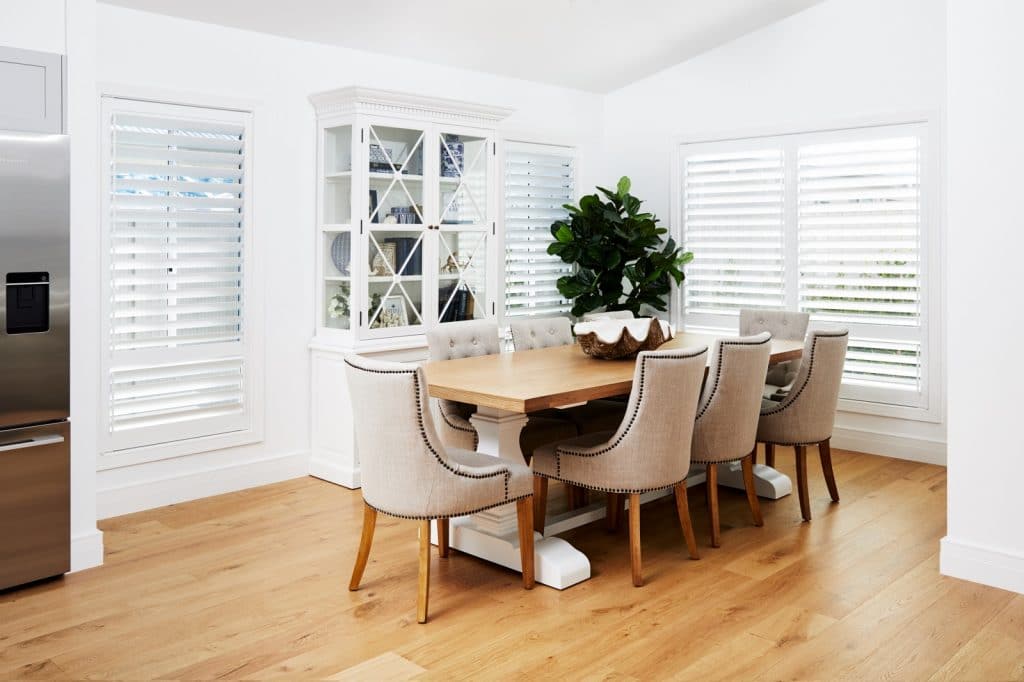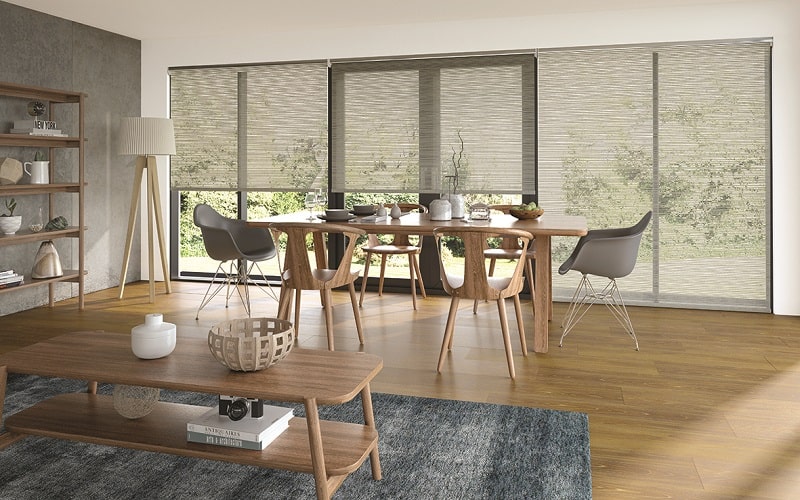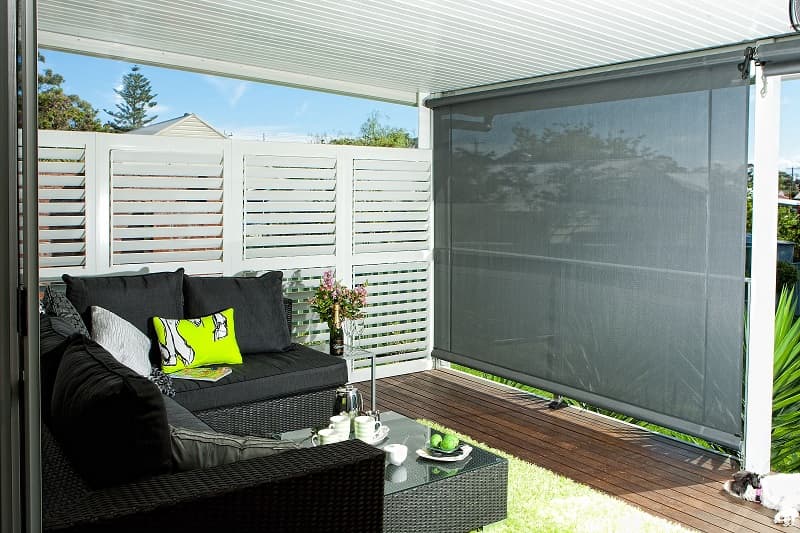Plantation Shutters vs Blinds: Costs & Considerations
- Updated on:
- Written by Bev Fidler
When it comes to choosing the perfect window treatment for a room, the choice between plantation shutters and blinds often surfaces. Both options have their place, and sometimes, the best solution might be a combination of both across different rooms.
Whether you’re renovating, building, or simply updating your window treatments, this guide will explain everything you need to know about plantation shutters vs. blinds, helping you make an informed decision that you’ll be happy with for years to come.
Plantation Shutters Vs Blinds: Understanding Your Options
Before diving into detailed comparisons, let’s explore what sets plantation shutters and blinds apart. Plantation shutters, with their timeless appeal, are permanent window fixtures featuring adjustable louvres mounted within a solid frame. Made from premium wood or durable aluminium, they offer a sophisticated blend of form and function.
On the other hand, blinds encompass a diverse family of window treatments, each with distinct characteristics. From the clean lines of roller blinds to the soft elegance of Roman blinds, each style brings its own benefits to your space.
Deciding on the Best Window Treatments for Your Space
The Investment Perspective
Understanding the financial implications of your window treatment choice goes beyond comparing initial price tags. Let’s break down the investment aspects of both options to help you make an informed decision that aligns with your budget and long-term goals.
Initial Costs and Long-term Value
While typically plantation shutters cost more, requiring a higher upfront investment, ranging from $300 to $800 per square meter depending on material choice and customisation, they’re often considered a permanent home improvement that can increase your property’s resale value. Real estate agents frequently cite plantation shutters as a desirable feature that can make a property more attractive to potential buyers.
Blinds, by comparison, generally present a more budget-friendly initial investment, with prices varying significantly based on style and quality. Basic roller blinds might start from $100 per entire window, while premium automated systems can rival shutters in cost. However, depending on usage and maintenance, blinds typically need replacement every 5-8 years.
Energy Efficiency Benefits
Both options can contribute significantly to your home’s energy efficiency but in different ways. Plantation shutters provide excellent insulation due to their solid construction and snug fit within the window frame.
When properly installed, they can reduce heat loss in winter by up to 40% and cool your home in summer by blocking up to 85% of solar heat gain. This efficiency can translate to lower energy bills and noticeable savings.
Quality blinds, particularly cellular or honeycomb styles, also offer impressive insulation properties. Many modern, vertical blinds are specifically designed to reflect heat in summer and retain warmth in winter. The ability to precisely adjust blinds throughout the day allows you to maximise natural light while minimising energy costs.
Property Value Considerations
From a property investment perspective, plantation shutters often have the edge. As a permanent fixture, they’re considered a capital improvement that can be depreciated for tax purposes in investment properties. Additionally, their durability and timeless appeal make them an attractive feature for future buyers.
While blinds might not add the same level of direct value to your property, their lower initial cost and flexibility make them a smart choice for homeowners planning to update their décor regularly or those working within a specific budget. The savings from energy efficiency and the ability to easily update styles can provide excellent value over time.
Style and Aesthetics
Plantation shutters and blinds offer distinct aesthetic advantages when it comes to making a style statement in your home.
Plantation shutters bring an undeniable sense of sophistication to any space. Their clean lines and architectural presence can transform an ordinary window into a striking focal point. Available in crisp whites, warm timber tones, or custom colours, shutters seamlessly integrate with both traditional and contemporary interiors.
Blinds, however, offer unparalleled design versatility. From minimalist roller blinds that practically disappear when raised to luxurious Roman blinds that add softness and texture, the design possibilities are extensive.
Modern blind collections feature an impressive range of patterns, textures, and colours, allowing you to make subtle or bold design statements. This flexibility makes blinds particularly appealing for homeowners who enjoy updating their décor regularly or maintaining different aesthetics in various rooms.
Traditional shutters can help maintain historical authenticity for period homes while providing modern convenience. Conversely, contemporary homes might benefit from the sleek lines of designer blinds, particularly in materials like aluminium or automated systems that complement modern architecture. The key is matching your choice to your current style preferences, your home’s architectural character, and long-term design goals.

Practical Considerations
Beyond aesthetics, the functionality of your window treatments plays a crucial role in daily living. Let’s explore the practical aspects that could influence your decision between plantation shutters and blinds.
Light Control and Privacy
Both options offer excellent light control, but their mechanisms differ significantly. Plantation shutters provide precise control through adjustable louvres, allowing you to direct light upward, downward, or straight through. This flexibility can be particularly valuable in rooms where you want to eliminate glare while maintaining natural light.
Blinds offer their own unique advantages in light management. Roman blinds provide similar directional control to shutters, while roller blinds can offer everything from complete blockout to gentle light filtering. The ability to fully retract blinds also allows for unobstructed views and maximum natural light when desired – something fixed shutters can’t provide.
Maintenance and Durability
Maintenance requirements often influence long-term satisfaction with your choice. Plantation shutters are remarkably easy to maintain, typically requiring only regular dusting and occasional wiping of horizontal slats with a damp cloth. Their durable construction and simple mechanism mean fewer parts can wear out or require replacement.
Blinds vary in their maintenance needs depending on the style and material. While roller blinds are relatively simple to clean, Roman blinds may require more detailed attention to keep slats dust-free. Fabric blinds might need periodic professional cleaning to maintain their appearance.
Climate and Environmental Factors
Your local climate should significantly influence your decision. Plantation shutters excel in harsh Australian conditions, offering excellent protection against heat and UV rays. Their solid construction also provides good sound insulation and can help protect furniture and flooring from sun damage.
When chosen correctly, blinds can be equally effective in climate control. Modern solar screen fabrics can block up to 95% of UV rays while maintaining views, and thermal blinds provide excellent insulation. However, certain window blinds may fade or warp over time in rooms with intense sun exposure, making material selection crucial for longevity.

Room-by-Room Analysis
Different spaces in your home have unique requirements, and understanding these can help you make the most appropriate choice for each room.
Bedrooms
In bedrooms, light control and privacy are essential. Plantation shutters provide excellent room darkening capabilities and sound insulation, making them ideal for light sleepers. However, modern blockout blinds, particularly in a double roller setup, can offer similar benefits at a lower price point.
Living Areas
For living spaces, versatility is key. Plantation shutters offer elegant light control and enhance street appeal, making them popular for front-facing rooms. However, blinds can provide similar light control while potentially offering less obstruction when fully opened. This can be particularly valuable if you have scenic views you’d like to preserve.
Bathrooms and Kitchens
Moisture resistance becomes crucial in wet areas. Aluminium plantation shutters excel here, offering water resistance and easy cleaning. While specialised moisture-resistant blinds are available, shutters generally provide better longevity in these environments. Both options work well for kitchens, though shutters’ easier cleaning and resistance to cooking residues give them a slight edge.
Installation and Maintenance
Proper installation and ongoing care of window covering are crucial factors in the longevity and performance of your window treatments.
While some blinds offer DIY installation options, plantation shutters require professional installation to ensure proper operation and warranty coverage. At Classic Blinds and Shutters, our expert installers ensure your shutters are perfectly fitted, taking into account factors like:
- Wall composition and window frame condition
- Precise measurements for optimal operation
- Proper alignment and levelling
- Secure mounting for safety and longevity
Blind installation, though sometimes simpler, still benefits from professional expertise, particularly for motorised systems or large windows. Classic Blinds and Shutters professional installation ensures:
- Correct bracket placement
- Proper tension adjustment
- Even operation
- Child safety compliance
Key Takeaways
- Plantation shutters and blinds are distinct window treatment options, each offering unique benefits in terms of style, functionality, and investment value.
- When deciding consider factors such as initial costs, long-term value, energy efficiency, property value, style and aesthetics, light control, privacy, maintenance, durability, and climate.
- Different rooms in your home have unique requirements for window treatments.
- Proper installation and maintenance are crucial for the longevity and performance of both plantation shutters and blinds.
Still Can’t Decide Between Blinds & Plantation Shutters?
Your decision on window coverings is really about your personal preference and unique needs. Plantation shutters offer elegance, durability, and excellent light control, while blinds provide a wide range of styles, materials, and price points.
Contact us today to book your consultation, and let us help you transform your windows into stunning features that perfectly balance beauty and functionality. Whether you choose to install plantation shutters, blinds, or a combination of both, we’re committed to helping you find the perfect solution for your home – contact Classic Blinds today!


